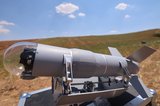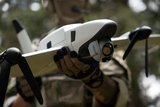BAE Systems' Mantis makes international debut at Aero India 2009
Visitors to Aero India 2009 will for the first time get a glimpse of BAE Systems vision of the future capability of autonomous Unmanned Aircraft Systems (UAS) when its MANTIS system goes on show to demonstrate to a new audience the technological developments that will shape future UAS capability.
MANTIS is a programme jointly funded by the UK Ministry of Defence (MoD) and UK industry to develop an autonomous Unmanned Aircraft System. The exhibition will be home to a full mock up of the large twin engine aircraft and will demonstrate MANTIS’ unique autonomous mission system capability through a fully operational Ground Control Station.
Andy Wilson, Business Development Director with Autonomous Systems and Future Capability at BAE SYSTEMS, said: “India has a projected large requirement for UASs and is currently expanding its UAS operations. UASs are expected to play a significant role in reconnaissance and long endurance surveillance missions in India and the MANTIS System is a large next generation highly capable system that is ideally suited to work of this kind.”
MANTIS is a fully autonomous next generation UAS, meaning it flies itself throughout the whole mission and the payload automatically detects and manages all target information. Autonomy greatly increases the effectiveness of operations by allowing commanders to focus on the overall task not vehicle control. This allows significantly reduced workload and manpower for operations, reduces risk of accidents due to human error and reduces communications/data link requirements between the vehicle and the ground.
Final assembly of the first aircraft is well underway and this will be followed by a period of ground testing to help prepare it for its first flight, which is due to take place over the next few months.
The MANTIS UAS advanced concept technology demonstrator programme will bring together technologies, capabilities and systems that will demonstrate the potential of a large unmanned aircraft to support future operational needs.
During phase one of the programme, BAE Systems has been working alongside the UK MOD and key UK industrial parties including Rolls-Royce, QinetiQ, GE Aviation, SELEX Galileo and Meggitt.
Andy added: “MANTIS is designed to carry out intelligence gathering at long distances. It’s a large platform with a wingspan of over 20 metres and it carries a significant payload in terms of sensors and potential weaponry. This phase of the programme will demonstrate that we have the capability to meet future operational needs.”
MANTIS is BAE Systems’ first genuine fly-by-wire, all-electric controlled aircraft; in MANTIS there are no hydraulics allowing the system to be broken down to fit into a C130 Hercules making it extremely deployable. MANTIS is designed to be a real workhorse with “plug and play” elements in the mission system and the ability to carry a wide range of sensors.
Key to the design philosophy for MANTIS is the ability to operate the system and transfer intelligence data collected independently of third party influence or infrastructure.
More from Uncrewed Vehicles
-
![What's next for the Pentagon after the Replicator programme?]()
What's next for the Pentagon after the Replicator programme?
Although the Replicator initiative has made several accomplishments, there are still multiple gaps to plug across the US Department of Defense (DoD) and its services.
-
![Cummings Aerospace showcases Hellhound loitering munition designed for US Army’s LASSO programme (video)]()
Cummings Aerospace showcases Hellhound loitering munition designed for US Army’s LASSO programme (video)
Cummings Aerospace presented its turbojet-powered Hellhound loitering munition at SOF Week 2025, offering a man-portable solution aligned with the US Army’s LASSO requirements.
-
![SOF Week 2025: PDW unveils attritable FPV drone for SOF operations at scale]()
SOF Week 2025: PDW unveils attritable FPV drone for SOF operations at scale
PDW has revealed its Attritable Multirotor First Person View drone at SOF Week 2025, offering special operations forces a low-cost, rapidly deployable platform for strike and ISR missions, inspired by battlefield lessons from Ukraine.
-
![SOF Week 2025: Teledyne FLIR white paper provides guidance on reusable loitering munitions]()
SOF Week 2025: Teledyne FLIR white paper provides guidance on reusable loitering munitions
Teledyne FLIR is highlighting the emerging requirements for 'recoverable and re-usable' loitering munitions across the contemporary operating environment during this week’s SOF Week conference in Tampa, Florida.
-
![SOF Week 2025: Kraken Technology group debuts K3 Scout USV in North America]()
SOF Week 2025: Kraken Technology group debuts K3 Scout USV in North America
High-performance maritime industry player Kraken Technology Group, based in the UK, has used the SOF Week conference in Tampa, Florida this week to debut its K3 Scout uncrewed surface vessel (USV) to the North American market.
-
![Palladyne AI and Red Cat to demonstrate capabilities for autonomous drone swarms to the US military]()
Palladyne AI and Red Cat to demonstrate capabilities for autonomous drone swarms to the US military
Red Cat and Palladyne AI recently conducted a cross-platform collaborative flight involving three diverse heterogeneous drones.

























